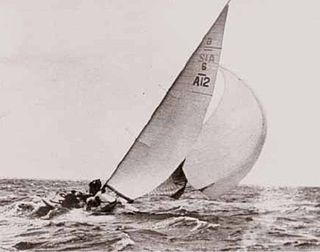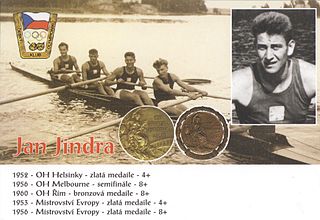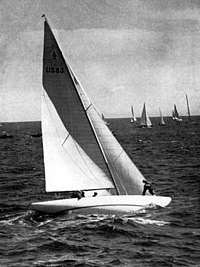
Venezuela competed at the 1952 Summer Olympics held in Helsinki, Finland. The Venezuelan Olympic Committee selected 38 competitors, 36 men and two women, to take part in 37 events across eight sports. This was a much greater turnout than 1948, Venezuela's only previous entry, which had only one athlete. For the first time, women represented Venezuela at the Summer Olympics. Women have been absent in the Venezuelan team on four occasions, including the next Summer Games held in Melbourne.

At the 1952 Summer Olympics in Helsinki, four diving events were contested.

Sailing/Yachting is an Olympic sport starting from the Games of the 1st Olympiad. With the exception of 1904 and the canceled 1916 Summer Olympics, sailing has always been included on the Olympic schedule. The Sailing program of the 1952 Summer Olympics consisted of a total of five sailing classes (disciplines). For each class seven races were scheduled from 20 to 28 July 1952 of the coast of Harmaja.

The men's 3 metre springboard, also reported as springboard diving, was one of four diving events on the Diving at the 1952 Summer Olympics programme.

The men's 10 metre platform, also reported as high diving, was one of four diving events on the Diving at the 1952 Summer Olympics programme.
The women's 3 metre springboard, also reported as springboard diving, was one of four diving events on the Diving at the 1952 Summer Olympics programme.
The women's 10 metre platform, also called high diving, was one of four diving events on the Diving at the 1952 Summer Olympics programme.

The 6 Metre was a sailing event on the Sailing at the 1948 Summer Olympics program in Torbay. Seven races were scheduled. 64 sailors, on 11 boats, from 11 nations competed.

The 5.5 Metre was a sailing event on the Sailing at the 1952 Summer Olympics program in Harmaja. Seven races were scheduled. 50 sailors, on 16 boats, from 16 nations competed.

The Dragon was a sailing event on the Sailing at the 1952 Summer Olympics program in Harmaja. Seven races were scheduled. 51 sailors, on 17 boats, from 17 nations competed.

Herman Frasch Whiton was the son of Henry Devereux Whiton and Frieda Frasch. He was an American sailor and Olympic champion. He was born in Cleveland to Henry Devereux Whiton and Frieda Frasch, heiress to the Union Sulpher Company. He was also the grandson of inventor and entrepreneur Herman Frasch and died in New York City. He was married to Emelyn Thatcher Whiton from 1939 to 1957. On Jan 15, 1958, Herman married Katherine M. O'Brien, 41 years of age.
Emelyn Thatcher Whiton was an American sailor.
The women's 200 metre breaststroke event, included in the swimming competition at the 1952 Summer Olympics, took place on 26–29 July, at the Helsinki Swimming Stadium. In this event, swimmers covered four lengths of the 50-metre (160 ft) Olympic-sized pool employing the breaststroke. It was the sixth appearance of the event, which first appeared at the 1924 Summer Olympics in Paris. A total of 33 competitors from 19 nations participated in the event.
The women's 200 metre breaststroke event, included in the swimming competition at the 1956 Summer Olympics, took place on November 29–30, at the Swimming and Diving Stadium. In this event, swimmers covered four lengths of the 50-metre (160 ft) Olympic-sized pool employing the breaststroke. It was the seventh appearance of the event, which first appeared at the 1924 Summer Olympics in Paris. A total of 14 competitors from 10 nations participated in the event. This was a decrease from the 1952 Summer Olympics, because the breaststroke event was split into the 200m orthodox breaststroke and the 100m butterfly event.
Over time, several scoring systems for Sailing were used during the Summer Olympics. Many of these systems were also used by other regattas in their times. In order to understand how the medals in the Olympics were handed out one must have a look at the scoring system of that specific olympic sailing regatta.

The Finn was a sailing event on the Sailing at the 1952 Summer Olympics program in Harmaja. Seven races were scheduled. 28 sailors, on 28 boats, from 28 nations competed.

The Star was a sailing event on the Sailing at the 1952 Summer Olympics program in Harmaja. Seven races were scheduled. 42 sailors, on 21 boats, from 21 nations competed.
The men's 4 × 400 metres relay event at the 1952 Olympic Games took place on July 26 & July 27.

The men's coxed four competition at the 1952 Summer Olympics took place at Mei Bay, Helsinki, Finland. It was held from 20 to 23 August and was won by the team from Czechoslovakia. There were 17 boats from 17 nations, with each nation limited to a single boat in the event. The gold medal was Czechoslovakia's first medal in the men's coxed four. Switzerland earned its third consecutive silver medal, and sixth medal in seven Games dating back to 1920. The reigning champion United States took bronze.

The team jumping or Prix des Nations at the 1952 Summer Olympics took place on 3 August, at the Helsinki Olympic Stadium. It was the eighth appearance of the event. For the first time, the event featured two rounds.















